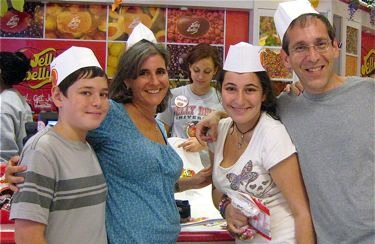Merav is out of the hospital and feeling a bit better. That should be cause for celebration. So why do I feel so confused?
These past weeks – how many has it been, six already? – have been pure hell. For us and for our extended families. Eleven-year-old Merav has probably been the least affected. She had the good sense not to dive into the endless “what’s causing it” debate that has been the organizing topic of every phone call and conversation we’ve had.
And that’s the thing: six weeks later, we still don’t know what caused Merav to get so sick she was admitted to Sha’arei Tzedek Medical Center for a week and to be out of school for much longer. She was tested for everything under the sun, and just about everything was ruled out, from hepatitis to parasites to gall stones and liver disease.
Our doctor says the jury is still out. Could be something chronic…or a rare virus that modern medicine just doesn’t know how to identify yet. Time will tell.
Or it may not.
As we’ve hovered in this seemingly perpetual limbo-land, one thing is for sure: we learned a lot about the Israeli medical system…and about how people relate to illness.
Dr. F., who took on Merav’s case as a personal challenge and at one point even convened a brainstorming session of 15 of the top pediatric specialists in Jerusalem, is notoriously non-invasive. His medical philosophy is to strive at all costs to avoid doing tests that could have complications, even if it means waiting it out for weeks with only slight day-to-day improvement.
Family and friends were less patient. Why hasn’t she had a CT scan, they asked? An Upper GI? Liver biopsy? Colonoscopy? All of these would have given us valuable data about possible chronic inflammatory disease that might be the root of Merav’s illness. But each has its risks.
CT scans involve a strong dose of radiation at a time when a young girl’s body is at a critical state of internal development. Liver biopsy can lead to infection or bleeding. Colonoscopy, well, that’s just plain nasty.
Add to that the fact that Merav does not deal well with invasive procedures in the first place. Just getting blood taken was traumatic. And it had to be done daily when she was in the hospital.
On one of her first blood taking expeditions, a particularly inept nurse must have poked her in half a dozen spots before finally having to get blood out from near her femur.
Next time out, it took a full hour of cajoling plus liberal application of Emla, a topical anesthetic, to get the job done.
Blood became our new language. One thing that just about anyone who enters the medical system can tell you is that you become intimately familiar with a wide range of information you never before knew a thing about…and will probably (hopefully) completely forget in a few month’s time.
I can recite the key indicators from Merav’s blood results by heart: Bilirubin down from 4.6 to 0.9. CRP up to 13.8, but dropping steadily to 8.9, then 3.2 and now 1.0. ALP, AST and GGT still high but falling too.
Despite her aversion to blood tests, we couldn’t help wondering: was biding our time being medically prudent…or ultimately irresponsible? Like everything having to do with parenting, it’s a fine balancing act.
Indeed, when Merav was at her sickest, Jody and I found ourselves going against our doctor’s advice, lobbying for taking a more invasive route. It’s natural, I suppose: there is probably nothing worse than seeing your child in pain, especially pain that lasts for weeks unabated. The knee-jerk response is to do something, anything.
But what if it turned out to be just a virus that needed an inordinate amount of time to pass? Or, given that we still didn’t know which haystack we were looking in – let alone which needle – we wound up ordering the wrong tests? What would be the ramifications of that misjudgment?
We tend to place our physicians on all-knowing pedestals. But as one friend said to Jody, “With all of the diseases out there, I’m amazed when they actually do know what’s going on.”
Merav still suffers from stomach cramps, though the pain is definitely down, her energy is up, and – most important – that plucky, playful attitude and presence that we missed so much around the house these past weeks is back for at least several hours a day.
Now that she’s home from the hospital and stable, we’re even starting to think about more mundane things, like getting her back to school.
“Not yet,” Dr. F. told us during an outpatient visit to his pediatric clinic as we reviewed her latest blood numbers. “She’ll let you know when she’s ready.”
Typical of his non-invasive approach. Merav liked that answer and gave him a slight smile.
And so we continue to wait and see. Because in our case, despite the constant chorus of concerned voices demanding a diagnosis, the truth is: no news really would be the best news.

